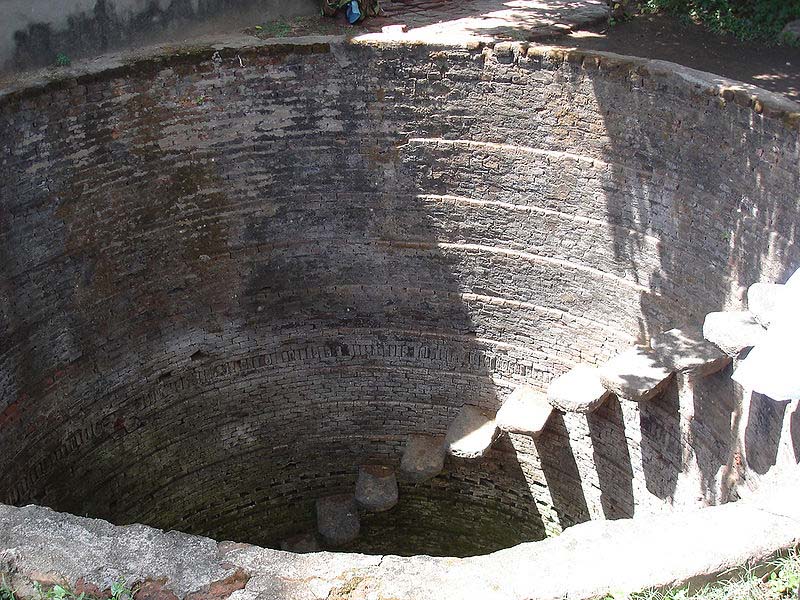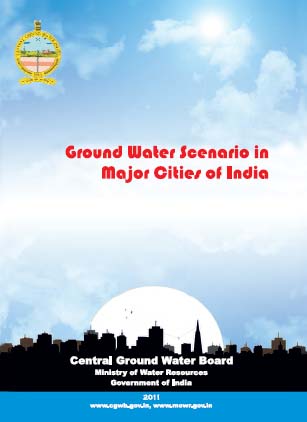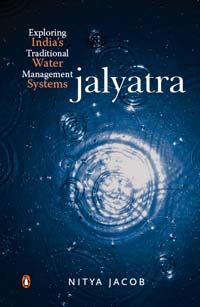Shallow Aquifers
Guidelines for successful well site selection – A paper in Current Science
Posted on 16 Jun, 2011 07:57 PMGroundwater is a natural replenishable resource. It is an important source for various purposes, including drinking, irrigation and industrial, due to insufficient surface water supply and frequent failure of monsoon. Identification of groundwater zones depends upon many factors such as distribution of rainfall, runoff, grain size of soil, topographic features, type of landform, drainage conditions, lithological characteristics, land use practices, depth to groundwater level and environmental constraints, which are not uniform in any area.

Image courtesy: Wikimedia Commons
Groundwater scenario in major cities of India – A report by Central Ground Water Board
Posted on 17 May, 2011 10:35 AM It covers varying groundwater scenarios in the country including the highly developed metros, the hilly region, the coastal cities, the cities tapping unconsolidated and hard rock aquifers. The report briefly describes the administrative set up, status of water supply and demand, groundwater scenario, feasibility of rainwater harvesting and groundwater development strategy.
It covers varying groundwater scenarios in the country including the highly developed metros, the hilly region, the coastal cities, the cities tapping unconsolidated and hard rock aquifers. The report briefly describes the administrative set up, status of water supply and demand, groundwater scenario, feasibility of rainwater harvesting and groundwater development strategy.
It is an updated version of an earlier report on “Groundwater in urban environment in India” (2000). Since then, groundwater regime, urban demography and water demand have changed enormously. This report will form a scientific base for an in-depth understanding of urban groundwater system including aquifer geometry, water level behavior and groundwater quality. The possibility of artificial recharge to rejuvenate the urban aquifers has also been discussed.
Agencies monitoring groundwater level in various parts of India in 2011 A list by the Central Ground Water Board
Posted on 16 May, 2011 07:26 PM
The CGWB has been monitoring groundwater levels on a quarterly basis during January, April/ May, August and November through a network of about 15000 observation wells located all over the country. This data is used for assessment of groundwater resources and changes in the regime consequent to various development and management activities.
Pampered views and parrot talks – In the cause of well irrigation in India – A paper by Institute for Resource Analysis and Policy
Posted on 15 May, 2011 06:14 PMIt is widely held that surface irrigation is becoming increasingly irrelevant in India’s irrigation landscape in spite of increased investments, and therefore future investments in irrigation should be diverted for well irrigation.
Jalyatra: Exploring India's traditional water management systems
Posted on 14 May, 2011 07:34 PM Jalyatra - Exploring India's traditional water management systems, by Nitya Jacob is an ecological travelogue that looks at links between water, society and places It describes in detail what existed, how it fitted into the socio-cultural milieu and was appropriate for the local climate and geography. It then examines reasons for their decline, as indeed most have, in recent decades.
Jalyatra - Exploring India's traditional water management systems, by Nitya Jacob is an ecological travelogue that looks at links between water, society and places It describes in detail what existed, how it fitted into the socio-cultural milieu and was appropriate for the local climate and geography. It then examines reasons for their decline, as indeed most have, in recent decades.
While recording the dismal state of traditional systems, the author stumbles upon small initiatives that have brought about significant transformation across regions. It refers to noisy hidrums and gharaats, the river-run flour mills of Uttaranchal, the technologies whose potential has yet to be fully realised. It looks at water harvesting structures of southern India—the eris and ooranis. However, it admits that the average person is singularly uninterested in protecting the environment.
Jalyatra captures the efforts of NGOs and enlightened individuals striving to revive these systems. It makes the case for a mass movement to revive traditional water management systems, especially village ponds, across the country as the way to ensure water security in India. In Chambal, the author meets Brij Mohan Gujjar, dacoit turned water conservationist, who is doing valuable work on the check dams designed to control the flow of water in the ravines; and in Shillong, Lan Potham shows him the uses of the easily available bamboo to construct the shyngiar which irrigates his areca nut plantation.
An analysis of West Bengal Ground Water Resources (Management, Control and Regulation) Act 2005
Posted on 11 May, 2011 02:17 PMIntroduction
Hydrology and quality of groundwater in and around Bangalore city - Review and excerpts from the report released in March 2011, by the Department of Mines and Geology (Govt of Karnataka)
Posted on 10 May, 2011 08:34 PMA welcome and important document, it brings up-to-date our understanding of the rapidly changing groundwater situation in Bangalore.
| Month | New borewells added each month | Borewells registered with BWSSB | Monthly % growth |
| Jan-09 | 91018 | ||
| Feb-09 | 924 | 91942 | 1.02 |
| Mar-09 | 705 | 92647 | 0.77 |
| Apr-09 | 965 | 93612 | 1.04 |
| May-09 | 1136 | 94748 | 1.21 |
| Jun-09 | 748 | 95496 | 0.79 |
| Jul-09 | 904 | 96400 | 0.95 |
| Aug-09 | 868 | 97268 | 0.90 |
| Sep-09 | 2062 | 99330 | 2.12 |
| Oct-09 | 838 | 100168 | 0.84 |
| Nov-09 | 875 | 101043 | 0.87 |
| Dec-09 | 2699 | 103742 | 2.67 |
| Jan-10 | 1759 | 105501 | 1.70 |
| Total as on Jan-2010 | 14483 | 105501 | 15.91 |
Growth of bore wells during February 2009 to January 2010 in Bangalore city
Between the city and the salty sea - The wells of Bhuigaon, Thane, Greater Mumbai - Guest post by MS Gopal
Posted on 22 Apr, 2011 05:57 PMAs the concrete jungle of Greater Mumbai reaches Bhuigaon and overuse of groundwater sucks in the sea water, the traditional wells are under threat.
Proposal for groundwater recharge in National Capital Region - A report by SK Sharma and Green Systems
Posted on 22 Apr, 2011 11:53 AMIt also explains the various laws that have been put in place to increase groundwater replenishment.
Guidelines for water safety plans for rural water supply systems - A document by SIAES and WHO India (2009)
Posted on 20 Apr, 2011 01:10 AM Delivery of safe drinking water is vital for protecting public health and of promoting more secure livelihoods.
Delivery of safe drinking water is vital for protecting public health and of promoting more secure livelihoods.
The traditional approach to water quality and safety management has relied on the testing of drinking water, as it leaves the treatment works or at selected points, either within the distribution system or at consumer taps. It is referred to as ‘end‐product testing’.





